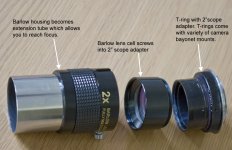After spending hours yesterday reading through all the posts and very helpful replies I decided to order this
SkyWatcher Evostar- ED 80/100/120 DSPRO Apochromatic refracter
The online shop
http://www.pulsar-optical.co.uk/prod/telescopes/sky-watcher/proseries/edrefractors3.html
manager was very helpful. He told me that although the Celestron ED80 which was discontinued and out of stock, had a low dispersion lens it was not as good an optic as the DSPRO which had the better fluorite "53" optics.
I must admit I could find no mention in any proper spec sheet that the Celestron had fluorite 55 glass. I assume this explains the price difference.
I decided to get a DSLMAX 2" adaptor to connect the camera directly to the telescope. A 2xBarlow lens, 2" diagonal and real 2" eyepiece comes with the package so I could also use it for viewing.
I have a Nikon D90 so high ISO noise free images are possible.
I will order a 1.4X Kenko Teleplus 300 Pro do add to the range and also this can be used with my Sigma 50/500 for nearer birds.
Will I need anytning else? I do have tripod already.
Thanks for help everyone and I will post when I get some pictures.
Cheers Richard
SkyWatcher Evostar- ED 80/100/120 DSPRO Apochromatic refracter
The online shop
http://www.pulsar-optical.co.uk/prod/telescopes/sky-watcher/proseries/edrefractors3.html
manager was very helpful. He told me that although the Celestron ED80 which was discontinued and out of stock, had a low dispersion lens it was not as good an optic as the DSPRO which had the better fluorite "53" optics.
I must admit I could find no mention in any proper spec sheet that the Celestron had fluorite 55 glass. I assume this explains the price difference.
I decided to get a DSLMAX 2" adaptor to connect the camera directly to the telescope. A 2xBarlow lens, 2" diagonal and real 2" eyepiece comes with the package so I could also use it for viewing.
I have a Nikon D90 so high ISO noise free images are possible.
I will order a 1.4X Kenko Teleplus 300 Pro do add to the range and also this can be used with my Sigma 50/500 for nearer birds.
Will I need anytning else? I do have tripod already.
Thanks for help everyone and I will post when I get some pictures.
Cheers Richard




